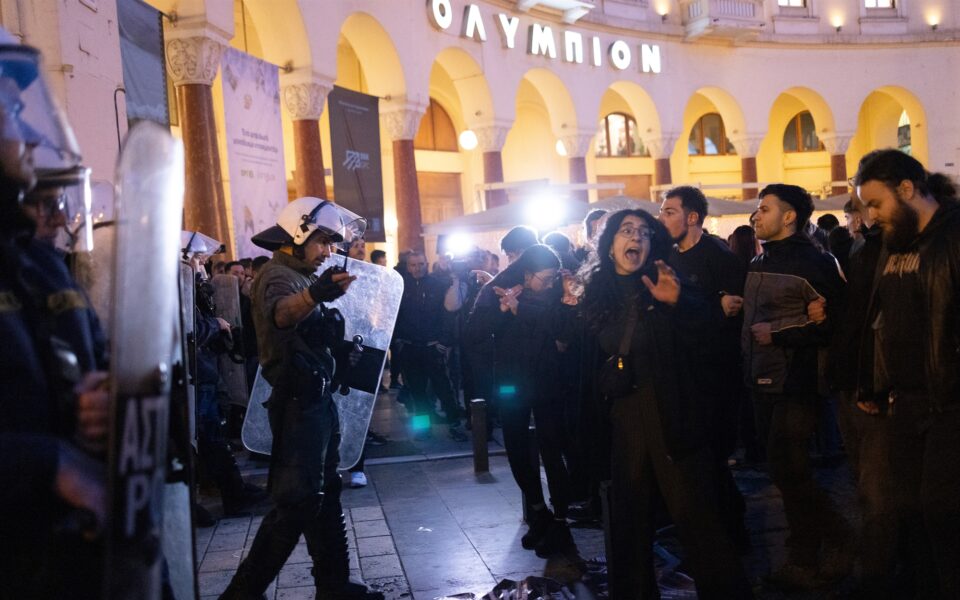How the internet is normalizing violence for Greek youngsters

The incident that shook Thessaloniki to its core a couple of days ago was an appalling scene: a mob of angry youngsters chasing, throwing bottles, and verbally assaulting two LGBTQ+ individuals in plain sight, in one of the city’s most prominent locations.
The episode becomes even bleaker if one pans out and looks at the bystanders surrounding the incident – a crowd standing idle, almost paralyzed, simply documenting the shocking scenes of violence and abuse with their mobile phones.
The big picture, however, may be even more sinister. Slowly but steadily, in ways that are both obvious and more insidious, the internet seems to be pushing Greek youngsters closer to violence and extremism.
The ways in which digital communities and content are making young people more likely to engage in violent behaviors is a global contemporary phenomenon, one that analysts have dubbed “online youth radicalization” and which has recently led authorities from Canada to India to take drastic action in order to prevent it. A quick glance into the darkest corners of Greek TikTok – where snippets of teenagers bullying classmates, engaging in violent acts, or frequently using hate speech and other slurs are abundant – is enough to make it clear that the phenomenon is rearing its ugly head in Greece as well, normalizing violence for the country’s youngest generations.
“Undeniably, the internet today essentially works as an incubating platform for violence,” Michalis Lolis, a police officer and LGBTQI+ activist, tells Kathimerini English Edition. “Social media provides the space for hate speech to be normalized, through its constant and unfiltered reproduction, and so it then becomes legitimized in the collective subconscious,” explains the officer, who is also an active member of the organization Greek Police for Human Rights. “What is worse, platforms very often do not allow the identification of the person who is propagating hate speech through posts, reposts or comments. So this protection ends up normalizing racism, homophobia, hate speech and abusive behavior, not only on social media and in public discourse, but also in the real world,” he adds.
For Lolis, there is little doubt that the toxic pushback against the marriage equality bill – which thrived in various virtual corners in recent months – contributed to the formation of the violent mob in Thessaloniki. “When the Church, political representatives and various other institutions essentially normalize hate speech and propagate it to society and Greek youth at large thanks to the internet, this awakens dangerous reflexes that very quickly translate into violent acts and hate crimes,” he notes. “This is closely related to the recent incident where we saw elements of mob mentality behavior. It is a phenomenon well documented by criminology experts: where there is unfiltered and massively reproduced hate speech, it quickly translates into hate crimes in a spontaneous, reflexive way that often includes mass mobilization.”
Shocked as she may be by the recent incident in Thessaloniki, Dora Kountoura – a teacher who has worked at various high schools in the northeastern suburbs of Athens – has noticed a general uptick in violent teenage behavior in the past few years, one that she also attributes to the fact that “the lines between the physical and the digital worlds are being blurred beyond recognition.”
“I can positively say that more and more teenagers are becoming verbally and socially cruel toward one another, especially after the pandemic ended,” the teacher tells Kathimerini English Edition. “They often use strong, discriminatory and emotionally charged language – such as slurs related to race, mental illness, neurodiversity, gender and sexual preference – in order to address peers in an insulting manner. This isn’t a new thing, but it seems to have become the norm at school and, even worse, it tends to have become totally acceptable and normalized within teenage groups,” she adds.
Based on conversations with her pupils in the classroom, Kountoura concludes that most teenagers don’t even realize that hate speech can cause tangible harm because they are accustomed to using this type of language extensively on the internet, where they don’t actually look at the person they may be addressing. “They feel that it is no longer a taboo to treat other people as if they are invisible, non-physical entities, just as they do on the internet. In other words, although they are not necessarily or deliberately cruel, they end up behaving with increased cruelty, and they are becoming accustomed to a type of performative cruelty,” she notes.
Research globally suggests that this type of performative cruelty cultivated online is more prevalent among teenage boys, something that Kountoura confirms based on her experiences in the Greek classroom. “Teenage boys today are extensively exposed to multilevel violent content online, through things such as communities and online groups propagating Andrew Tate’s hate speech rhetoric” she says in reference to the American-British social media personality, businessman and former professional kickboxer whose controversial commentary has resulted in his expulsions from various social media platforms and concern that he is encouraging misogynistic views among young males. “Those groups combining fitness workouts, how-to-conquer-a-woman tutorials and covered-up alt-right brainwashing are extremely popular. What is worse is that teenage boys often refuse to see the truth or understand that they are being manipulated,” she concludes with concern. “For example, they keep on believing that Andrew Tate is just a nice guy who gives perfect tips for working out and hitting on women, even when you demonstrate proof of his criminal activity.”
For Triantafyllos Karatrantos, a senior research fellow at the Hellenic Foundation for European & Foreign Policy (ELIAMEP) who specializes in radicalization, the recent burst of violence in Thessaloniki is part of a wider trend of extremism in the city, a consequence of increasing sociopolitical polarization connected to earlier incidents, including the violent attacks in schools in the suburb of Stavroupoli that took place three years ago, as well as hooliganism. “We see a definite trend of an increasingly younger age of radicalization, which has to do with sociopolitical perceptions,” he notes. “Essentially, we have more and more young people who react with intensity to a social trend or a political choice, and who manifest their reaction through violence. Some may be motivated sociopolitically, while others are simply by exposure to the culture of violence, but there is undeniably a greater involvement of young people in violent behavior,” he underlines.
The researcher sees a plethora of reasons that may lead younger Greeks toward violent behaviors, but he also agrees that the biggest contemporary challenge is radicalization through the internet.
“The new generation has a massive reliance on mobile phones and has created a different language, based on interacting on social media and communication platforms. This is linked to a structural component of radicalization, which is iconography: that is, how violence is transferred to online communication as a form of projection,” he explains. “A violent young man wants to project his violence online, to humiliate his victim, but also to gain reinforcement from disseminating this image,” he adds, referring to a phenomenon where Greek teenagers post videos on social media showing off their violent behavior, often in an attempt to solicit likes, comment and online attention.
Additional digital pathways toward violence, according to Karatrantos, include communication through encrypted messaging platforms or the dark web, as well as constant exposure to a culture of violence and violent discourse. “In the past, for a person to come into contact with extremist content of any kind, they would have to go to a physical location,” he says. “Today, a teenager can access a vast amount of extremist or violent content from the comfort of his or her home.”
Though concerned about the additional challenges that technological advancements, such as artificial intelligence and deepfakes, may pose when it comes to online youth radicalization, Karatrantos believes that solutions are possible, albeit not easy. “The problem is that public debate and interest around youth violence usually comes after the violence has taken place,” he says. “We need to work proactively, and we also need technology on our side as an ally to deconstruct the concept of violence and its appeal.”
Though there are numerous reasons for extreme concern when one looks into how the internet is normalizing violence for the Greek youth, it is not all cause for panic. In fact, some argue that the internet may also be responsible for another, more positive phenomenon: bringing nationwide attention to cases that would previously remain local and obscure.
“I’m not necessarily sure that we have more youth violence today, I just think that we learn about it much faster,” says Lolis, drawing on his years of experience as a member of the Greek police force. “We live in the age of information, and so a violent incident among youngsters in a small town, which would have stayed among local communities, can now reach audiences nationwide. A second aspect is that as Greek society has evolved, it has become more aware and it gives discriminatory violence the necessary attention,” he concludes. “In the past, many attacks against individuals belonging to minority groups – whether they were women, LGBTQI+ or migrants – were internalized, sometimes kept silent even by the victims themselves. Today they are given attention and visibility, and that is a step in the right direction.”





